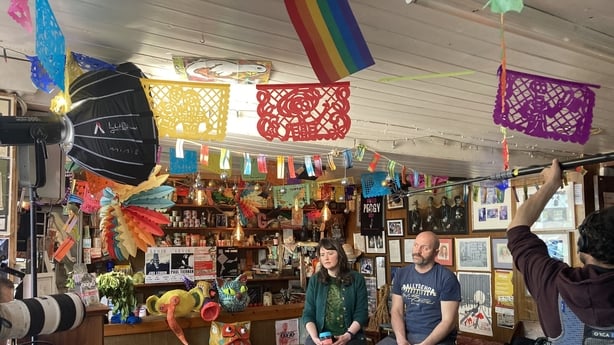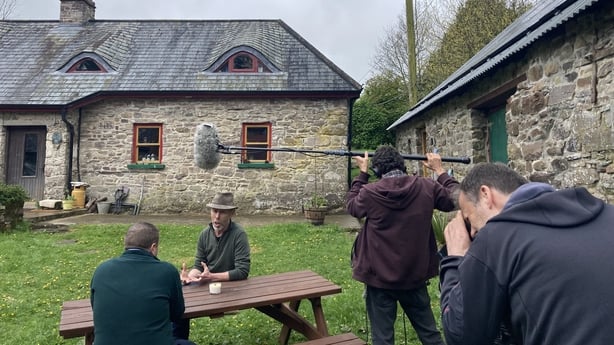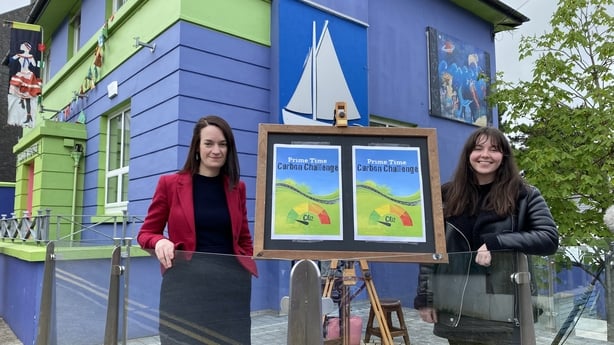Most of us know that we need to curb our carbon emissions if we are to give ourselves any chance in fighting the climate crisis.
"The climate emergency is a race we are losing, but it is a race we can win," UN Secretary-General Antonio Guterres said.
The race is certainly on, but do we fully understand the impact our day-to-day travel has on the environment? In other words, how carbon literate are we?
Prime Time took to the streets of Ballydehob in West Cork to find out.
Levi's Corner House pub is a focal point of the Ballydehob Jazz Festival. It is run by festival organisers, Joe O’Leary and his partner Caroline O’Donnell.

The couple are very aware of the challenges people who live outside Ireland’s main towns and cities have in accessing sustainable modes of transport.
With buses going infrequently, Caroline says that getting to Ballydehob is "a convoluted journey."
Caroline told Prime Time, "We're limited with public transport options, if you look at it from a sustainability point of view, in that you want to do it with the least carbon footprint."
Joe says it took a friend five hours to get from Cork City to Ballydehob last week. One scheduled bus from Cork to Skibbereen was cancelled. He had to wait for an hour on another bus to take him the short 16-kilometre distance from Skibbereen to Ballydehob.
Joe added that most people cannot afford electric cars. Like the majority of rural towns and villages there is no public EV charging point in Ballydehob.
"We've had maybe a thousand bands passing through here in the last ten years - one band has come in an electric vehicle!" said Joe.
One of the bands to travel to Ballydehob was Taranta Celtica, a new collaborative group that fuses traditional Irish and Southern Italian Tarantella music.
The seven-member group came together for the first time at producer David Teevan’s home near Grangemockler in rural Tipperary.

Band members flew in from Portugal and Italy and drove from different parts of Ireland to meet in Tipperary. From there, they car-pooled into three cars and set off on a tour that culminated in headlining the Ballydehob festival.
Mr Teevan said, "We set out with the idea of kind of seeing could we reduce the carbon footprint of the tour, and at best, could we offset the damage we were doing?"
The EU’s Culture Moves Europe, that part-funded the artists travel to Ireland, paid to carbon offset their flights. The band also used public transport where possible and car-pooled into three cars for their journey from Tipperary to Cork.
David Teevan said, "The Lough Grainey Nature Sanctuary in Clare has set up an offsetting portal for arts organisations. So, we can go in, input our travel details travel and make a gesture in terms of an environmental investment to offset the travel."
Prime Time tracked Taranta Celtica’s journey to Ballydehob and enlisted the UCC carbon emissions experts to work out the band’s carbon footprint.
Dr Marguerite Nyhan, is an Associate Professor in Future Sustainability and Environmental Engineering at UCC. She was joined in Ballydehob by PhD candidate Lily Purcell to crunch the numbers.
Their analysis found that the band’s total carbon footprint was 3,099 kg of CO2 equivalent. CO2-equivalent is the metric used to measure our carbon emissions.
It's important to point out that the flights account for a huge portion of the band's total carbon footprint.
Had the band had not carpooled, it would have risen to 3,522 kg of CO2 equivalent.
If they had replaced their own cars with electric vehicles, the total carbon footprint would have dropped to 2,192 kg of CO2 equivalent.
Well-known composer and percussionist Dave Boyd, a member of Taranta Celtica, travelled from Portugal for the tour. He used public transport on either side of the flight to Dublin.
He told Prime Time, "The issue for musicians always is that we are not time rich, and we must get to places. For touring musicians, the margins are tiny."
Dave Boyd’s conundrum of wanting to travel sustainably while facing hurdles around the cost and time, are widely shared.
In a sample survey of the artists attending the festival, Prime Time found that 60% had issues with the inadequacy of public transport. They were willing to use low-carbon transport options, with 70% of them carpooling to get to the festival.
Thousands of people converge in the scenic village every year for the Ballydehob Jazz Festival. As people arrived last weekend, Prime Time asked them where they had travelled from? What mode of transport they used? And, if they had any idea what their carbon footprint for the journey amounted to?
One woman travelled by train from her home in East Sussex to Gatwick Airport. She flew to Cork before hiring a car and driving to Ballydehob.
She admits she had "absolutely no idea" what her carbon footprint for the journey was.
After analysing the numbers on the woman’s trip from East Sussex to West Cork, Dr Nyhan said it amounted to 163 kilograms of CO2 equivalent.
While the total CO2 equivalent of the UK to Ballydehob journey was 163 kilograms, Dr Nyhan pointed out, "Your flight from Gatwick to Cork was 95% of the carbon footprint."
This finding highlights how air travel is a huge contributor to a person’s carbon footprint.
A group of five women who had car-pooled to travel from Portlaoise to the festival said they had "not a clue" what their carbon footprint was.

UCC’s Lily Purcell calculated it for the five Laois women and found that their carbon footprint was seven kilogrammes of CO2 equivalent each and that if they had driven separately instead of carpooling it would actually be about 36 kilogrammes of CO2 equivalent each.
"You actually reduced it. So, I think, you made the best choice."
After Prime Time surveyed people in Ballydehob, Dr Nyhan said it was evident that people may not know what their transport carbon footprint is, but they are very aware what they can do to reduce it.
But she added, "We are also seeing that sometimes those alternative low-carbon mobility options aren't feasible or aren't available for some. For example, a couple spoke about the lack of EV charging infrastructure in this area."
The emissions expert says that providing people with a personalised carbon footprint summary "is a really good way of raising awareness and helping people to make more informed decisions."
Watch 'The Carbon Challenge…and all the jazz’ - Reporter Conor McMorrow and producer Lucinda Glynn’s report on the RTÉ Player.





